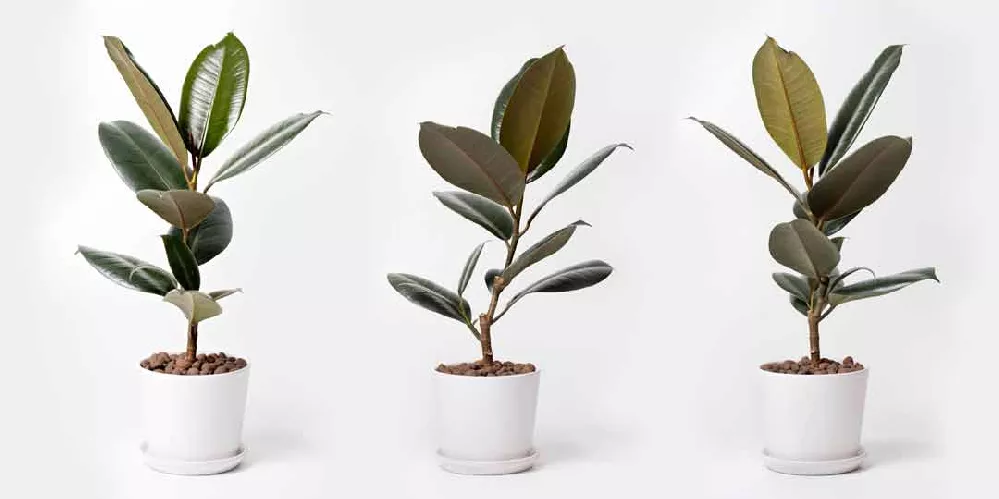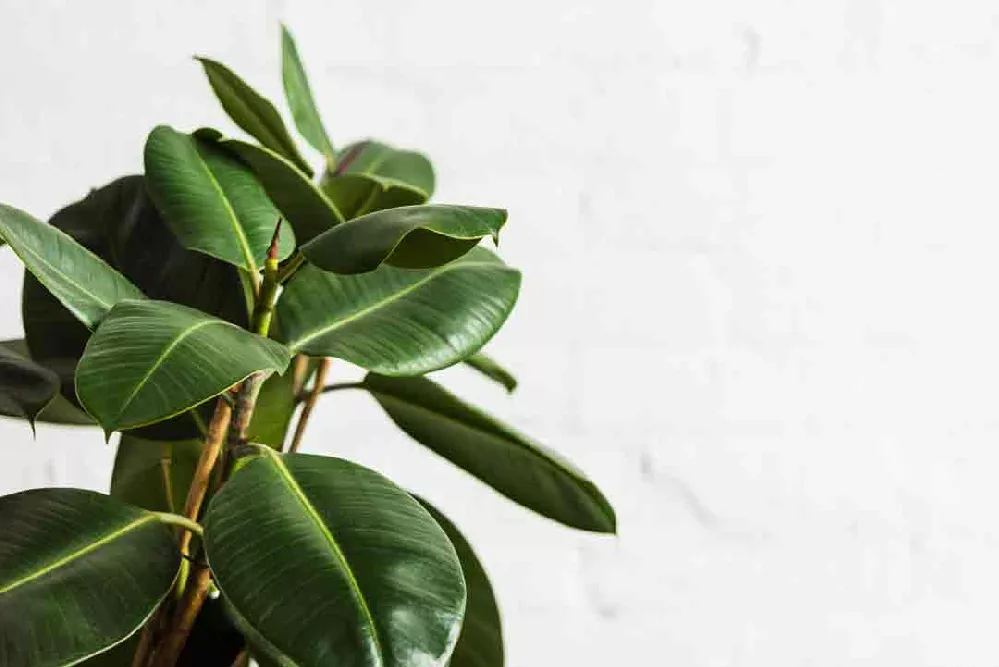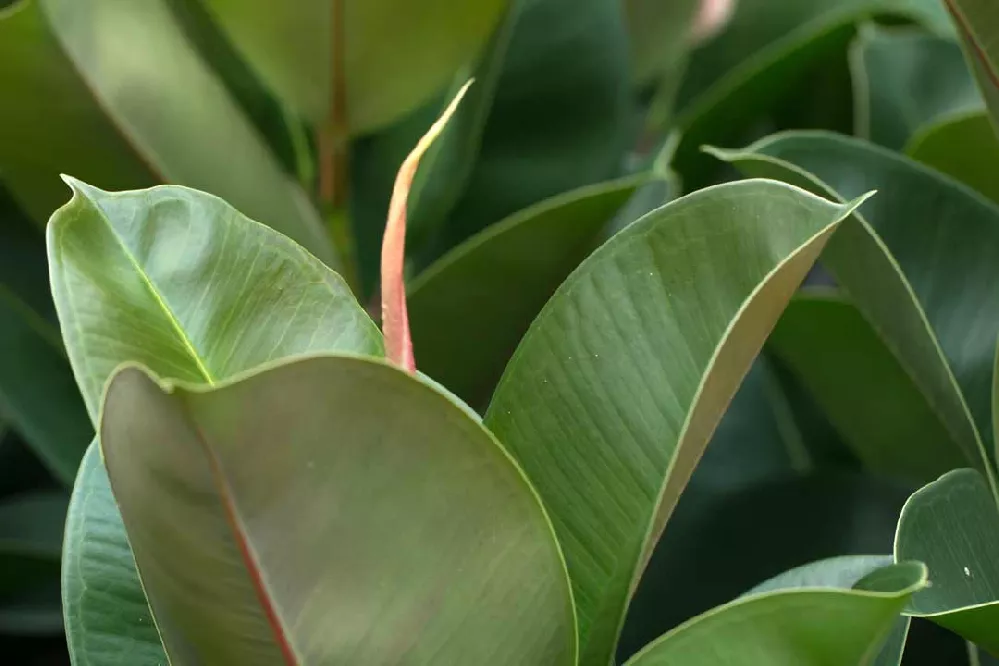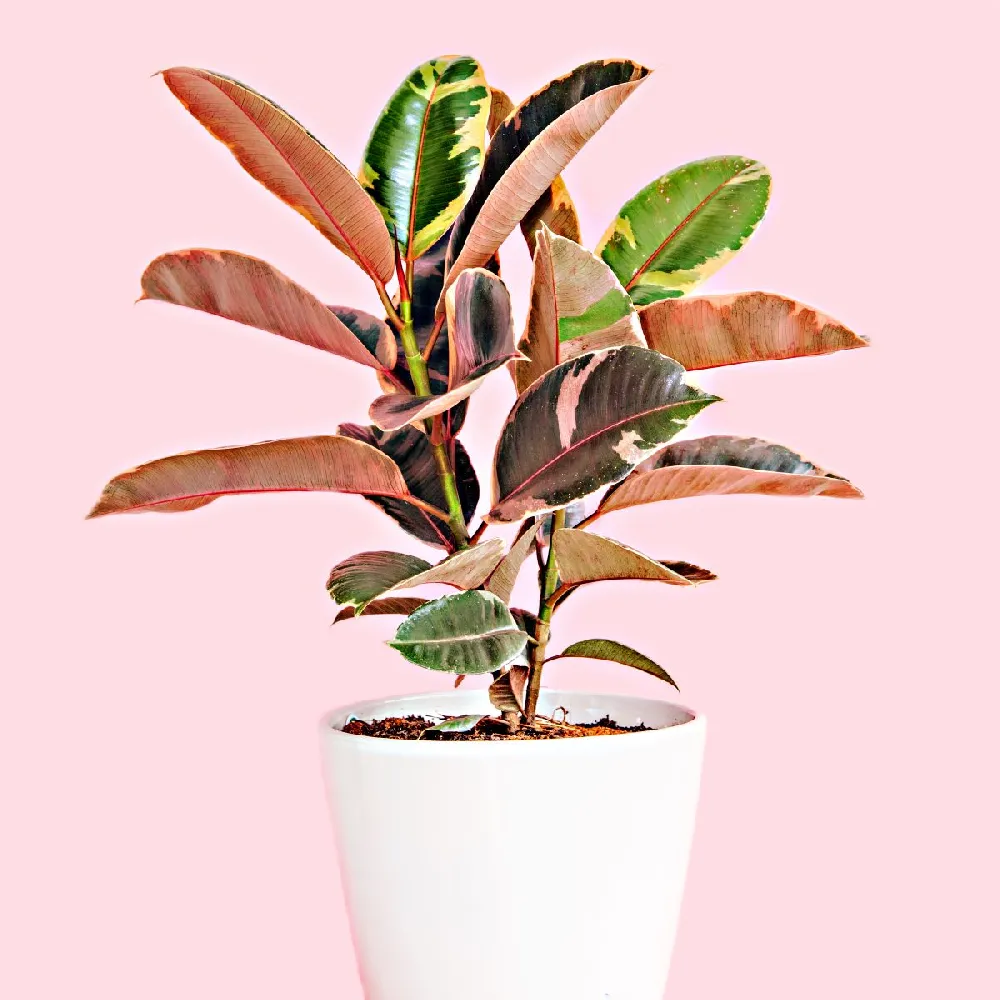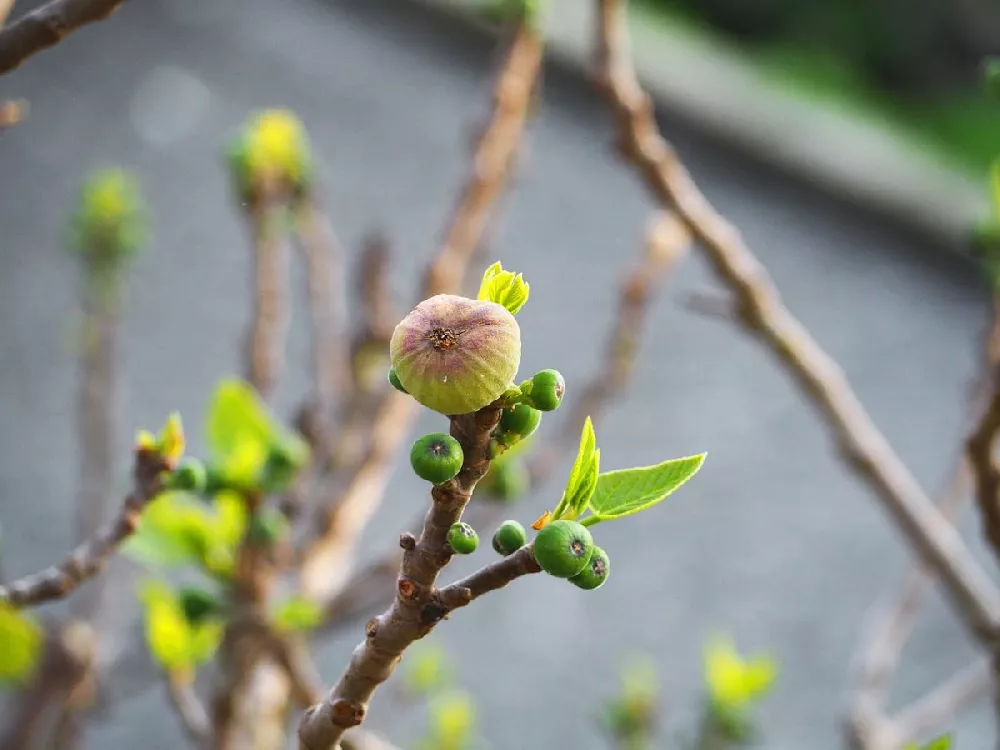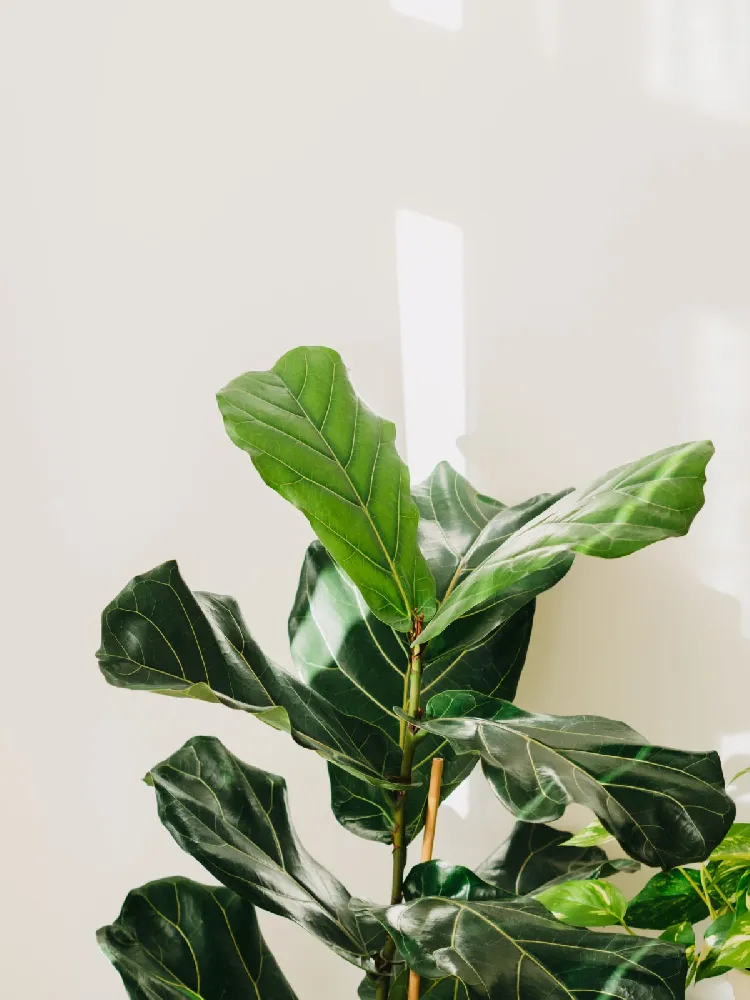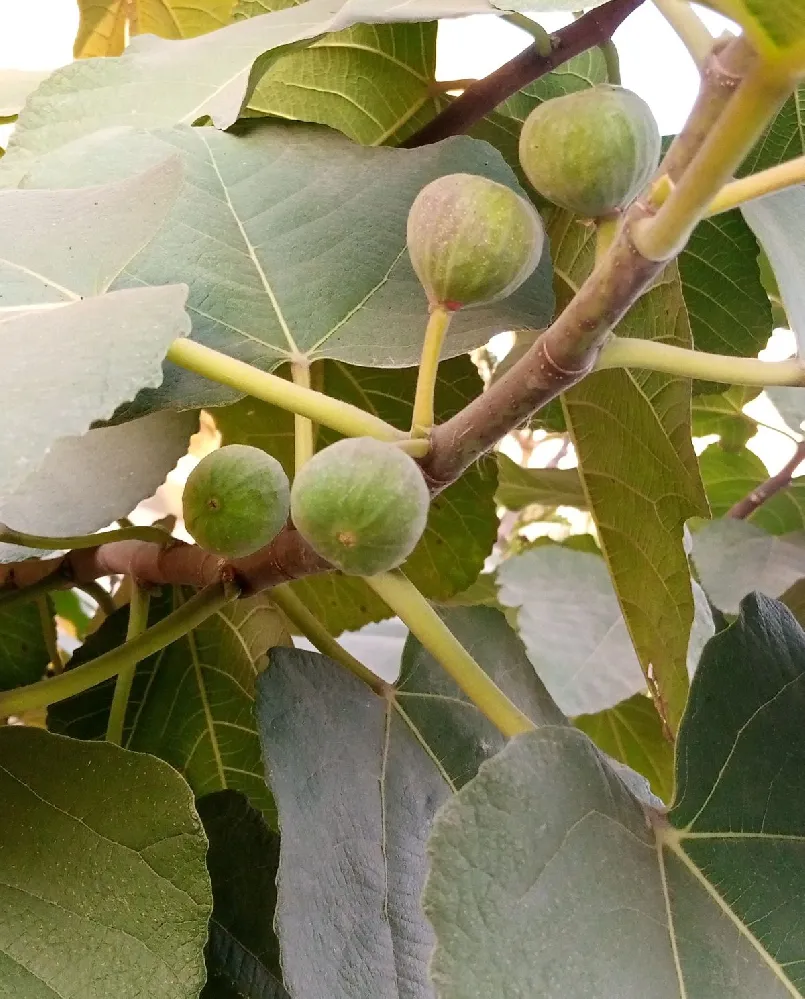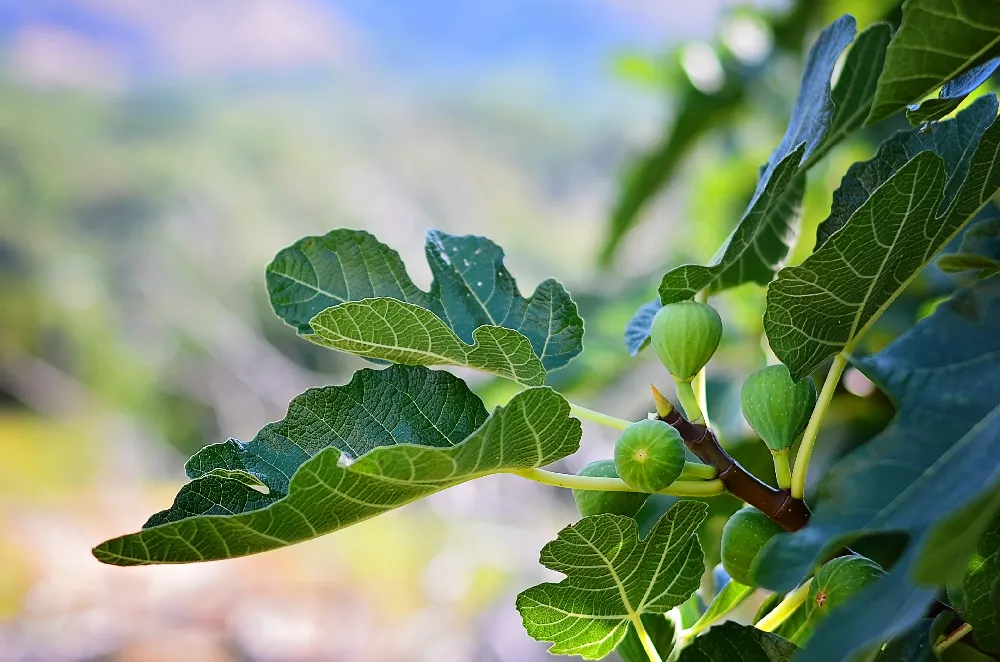- Home >
- Houseplants >
- Rubber Plant (Ficus)
Rubber Plant (Ficus) for Sale - Buying & Growing Guide
- Ships in 1-2 days
- 1-Year Warranty Eligible
- Pots or accessories are not included unless specified in the product options.
Shipping Details:
Once your order is shipped, you’ll receive an email with a tracking number and estimated delivery date. Most orders ship immediately, but some items are seasonal and may only ship in spring or fall. These products are noted on the website.
Rubber plants (Ficus elastica) are popular indoor plants because of their robust green leaves and woody elements. Interior public spaces such as shopping malls, atriums, and lobbies often include this plant in their decor. Being relatively easy to care for and hardy, the rubber plant is great for beginners to grow. Here are a few intriguing things to know about the rubber plant:
- Grows about two feet per season.
- Can live up to 100 years when cared for properly.
- Is famous in feng shui for good fortune.
Plant Care
Sunlight

Grows well in plenty of indirect or filtered light.
Watering
When dormant, water once per month. When growing, keep soil consistently moist but not wet. Mist leaves occasionally.
Fertilizing

Fertilize once per month in the growing season with a general-purpose fertilizer.
Planting and Care
Planting instructions
Rubber plants do well as outdoor container plants in zones 10-11 with temperatures between 65 to 80 degrees Fahrenheit. When outside temperatures drop to the low forties, bring the plant indoors. As indoors plants, place your container in an area out of direct sunlight. Select a large, well-draining container half an inch larger than the root ball. A well-draining potting mix is a must for these plants. Using three-quarters Miracle-Gro Indoor Potting Mix with one-quarter Miracle-Gro Succulent Mix provides your rubber plant the right soil environment.
Watering and nutrients
To prevent root rot and other diseases, never overwater your rubber plant. If the soil one inch deep is dry to the touch it’s time to water. Water the plant at the base of the stem while being careful not to get the leaves wet. Add enough water to thoroughly wet the soil. Never allow your plant to rest in a tray of water with other plants because this encourages disease. Fertilize your rubber plant about every three months with a 10-10-10 fertilizer such as Bonide Liquid Plant Food.
Pollination
Interestingly, rubber plants outside of their native habitat of Southeast Asia will not produce fruit/flowers. Pollination for these plants rests solely on a specific species of wasps (Blastophaga clavigera) only found in India. Native plants in Southeast Asia require these wasps for pollination. Female flowers attract the wasps where these pollinators (female wasps) lay eggs while also depositing pollen from another flower. As the eggs hatch, the new wasps mate while inside the flower. These wasps leave the flower with pollen attached, and the entire process repeats itself.
Pruning
It’s best to prune your rubber plant in the early summer, and to begin pruning when your plant is young, as pruning helps you maintain control of your plant’s size. Select the desired branch to cut off. Using disinfected, sharp shears, cut one-third down on the branch at a 45-degree angle.
Pests and diseases
Rubber plants are disease resistant and have very few problems with pests or diseases. Root rot is very common in indoor plants. This can be prevented by not overwatering, using the right potting soil, and planting in a well-draining container. Never allow the plant to sit in communal trays of water. Pests such as mealy bugs, aphids, spider mites, and scale insects can easily be treated with Bonide Neem Oil.
Humidity
The Rubber plant isn’t too fussy when it comes to humidity, and should be quite happy kept in the regular humidity conditions you find in homes. If the leaves start to look dry, you can mist them with a spray water bottle, but this isn’t a necessary part of a Rubber plants routine care unless you are experiencing exceptionally dry air.
Temperature
The Rubber plant does well in a broad range of temperatures, from 50-85° F. It can quite happily withstand both high and low temperatures, though anything over 85° F will result in the foliage losing its plump appearance, and leaves may look neglected and shrunken. Low temperatures can be tolerated, though anything lower than 45° F would be considered risky. The plant may be able to survive during temperatures as low as 40° F, though watering at this temperature would have to be very precise; otherwise; overwatering at such a low temperature would certainly kill the plant.
While the Rubber plant is tolerant to a variety of climate conditions, it doesn’t like sudden change and should, therefore, be kept away from cold draughts or sudden temperature drops. It doesn’t like to be moved around too much, either, so find a place for it to live where it will be happy all year round, away from a door or window where cold bursts of air may be an issue.
Light
The Rubber plant enjoys bright conditions, away from direct sunlight. It shouldn’t be kept in rooms with low light as it will struggle to thrive and experience stunted growth and other problems. While it will do best in bright, filtered light, it can tolerate a few hours of direct sun each day, preferably during the morning when the sun is not at its strongest. Too much direct light will result in the leaves becoming scorched. If your room receives a lot of direct sunlight, you should think about finding a new home for your Rubber plant in a different room, or using curtains or blinds to filter the light.
Varieties of the Rubber plant with the typical glossy green leaves can do relatively well in partially shaded areas, though you will need to keep an eye on its growth because a lack of bright light can result in the plant becoming scrawny looking. If your Rubber plant has variegated leaves, then low lit conditions are not an option. Bright light is required for these plants to maintain their markings; otherwise, their colorings will fade, and they will look much less healthy and appealing.
Repotting
When your Rubber plant is still young, it will need to be repotted each time the roots become pot bound, usually annually. To repot, remove the plant from its current pot, being careful not to harm the root system, and gently remove excess soil. Then, choose a pot with a few extra inches of growing space, and place the plant in it with fresh soil so that the plant can get the benefit of fresh nutrients. Water your newly potted Rubber plant, and continue as usual. As your plant matures, it will need repotting less regularly, as growth will slow down. Your plant can be repotted every three to four years rather than every year, though you can change the topsoil in between repottings to help freshen things up and aid your Rubber plant in thriving.
Propagation
Rubber plant propagation is not enormously popular among Rubber plant owners for a variety of reasons. Firstly, Rubber plants are so large that just one of these plants in a household is usually enough, and people do not have the desire to grow more and own a series of Rubber plants. Rubber plants are also very cheap to buy, so most people wanting to add a Rubber plant to their collection would choose this option. Rubber plants are also not the easiest plant to propagate, either, and efforts will often be wasted and lead to unsuccessful propagation. However, it can be done in two different ways, and makes a good challenge if you are keen to propagate your houseplants. Rubber plants make excellent gifts, so if you do decide to propagate your houseplant, you may decide to gift them to your friends and family.
To propagate using a stem cutting, select a cutting to use in spring or summer. You will need a cutting which is at least six inches in length, and that has a minimum of two sets of leaves. Carefully remove the bottom set of leaves from the stem, and dip the base of the stem in rooting hormone. This step is not essential, though using rooting hormone will help to increase your chances of success. Place the stem in a gritty or well-draining compost or potting soil and cover it with a glass jar or clear plastic cup. Make sure that none of the leaves come into contact with its clear covering, trimming the edges of the leaves if necessary. The stem must then be kept in bright but indirect light, with constantly moist soil. It should be kept warm, with heating from underneath providing the best results. In a few weeks, when the stem has rooted, you can remove the glass or plastic covering.
To propagate using air layering is to root a ‘cutting’ while it is still attached to the mother tree. This method is usually has a higher success rate, though it is slightly more complicated. The first step is to select a stem on your Rubber plant that is a minimum of twelve inches long. Carefully remove any leaves that sit immediately above and below where you plan to root the stem. Then, use a sharp knife to remove a one-inch ring of bark from around the stem, making sure the internal wood center remains intact. When finished, your stem should appear to have a bare ring around it.
All soft tissue in the ring must be removed. Follow this up by applying rooting hormone to the ring, and then covering it with moist sphagnum moss. Cover the sphagnum moss with a plastic film, securing it in place around the stem. The sphagnum moss must be completely surrounded by the plastic wrap, which will help to ensure it remains damp. After a few weeks, you can remove the plastic covering and the sphagnum moss, revealing newly sprouted roots on the ring of the stem. Once this has been achieved, you can cut off the stem at the roots and plant it in a pot with potting soil or compost.
Toxicity
The Rubber plant contains a sap that is toxic to both animals and humans. Both the leaves and the stem produce a milky sap, containing caoutchouc, which is irritating to the skin, eyes, mouth, and gastrointestinal system. It can be especially painful if it gets into open wounds, so it is recommended that you wear protective gloves when pruning the plant to protect your skin from harm. The plant should be kept away from children and pets, though effects should be mild if they do come into contact with the sap.
The toxicity of the Rubber plant is classed as level 4, which is the least toxic level a plant can be. Its effects can be as minor as mild skin irritation, or it could cause a severe rash and skin blistering. The sap is poisonous to pets, and, if ingested, can cause vomiting and internal discomfort, though it is not thought to be fatal (The University of Kansas Health System).
Common Problems
Yellowing foliage
This can occur for a number of reasons, and you will likely have to perform a process of elimination to understand what is causing your leaves to yellow around the edges. Overwatering can contribute to yellowing leaves, so if you suspect this may be the problem, then be sure to allow the soil to dry out between each watering, and this may solve the issue. A lack of nutrients could also cause leaves to yellow, which could happen in the form of poor soil, or underuse of fertilizer. If your Rubber plant is due to be repotted, then doing this and having fresh nutrient dense soil may fix the problem. If you haven’t been utilizing fertilizer effectively, then this could also be the culprit behind yellowed foliage. Use a weak fertilizer little and often. A high-nitrogen fertilizer will help keep your leaves in their best shape.
Leaf drop
Some leaf drop is normal, especially among the lower leaves. However, if you’re noticing piles of leaves around the base of your plant, then there is probably a problem with the conditions the plant is being kept in. Overwatering is the most common cause of Rubber plants losing their leaves. If this is the case, repot the plant in new soil and cut back on your watering schedule. One good watering a week should be plenty during the growing season. If you don’t resolve the issue, it could lead to the death of your plant.
If overwatering is not the cause of your leaf drop, then a sudden temperature drop or lack of light could be the problem. Try to ensure your plant is kept away from cold drafts, and make sure it is getting enough indirect bright light. Some people move their Rubber plants outside during the summer to encourage growth, which may help with leaf drop, but try to protect it from more than a few hours of direct sunlight.
Dust
The most common problem for houseplants with large leaves is dust. Dust covering your plant’s foliage can filter out the light, meaning the plant isn’t benefiting from the bright conditions you have placed it in. This problem is easily fixed with occasional cleaning of the leaves. To do this, wipe the leaves gently with a damp cloth every few months.
FAQs
Are there different types of rubber plants?
There are numerous varieties of the Ficus elastica (rubber plant). A few noteworthy ones have variations in color and leaf size. Selecting a variety comes down to personal preference in the overall appearance regarding plant size and color of foliage. A few varieties include:
- Robusta: the largest rubber plant type featuring bigger, darker leaves.
- Decora: features large, variegated leaves.
- Burgundy: also called “Black Prince,” with deep, bold burgundy/black leaves.
- Tineke: known for its variegated white and pink leaves.
- Belize: features variegations of pink.
Are rubber plants safe around pets and small children?
No, rubber plants are toxic to pets and small children. The sap produced by the plant irritates the skin and, if ingested, inflames the mouth, throat, stomach, and intestine. Pets/children chewing on the plant or putting it in their mouth experience vomiting, excessive drooling, and diarrhea. When the sap comes into contact with the skin of a pet or child, it can cause a rash.
Are rubber plants the same thing as a fig tree?
The Ficus elastica (rubber plant) belongs to the genus Ficus, which are figs. Within the Ficus (fig) genera, there are many species of plants including the rubber plant. One fig-type plant is the Ficus carica, a fig tree with the edible fruit we are familiar with.
Can a rubber plant be planted in the ground?
Yes, you can plant your rubber plant in the ground provided you are in zones 10-11. Landscapers often use these plants for ornamental plantings along streets, in highway medians, and around pool areas. Rubber plants are susceptible to frosts and cold temperatures. They also have weak wood causing them to break easily under heavy rain, ice, and winds. Planting them outdoors puts them at risk of powdery mildew, and other diseases and pests.
Do indoor rubber plants need artificial lighting?
If your house is dark and lacks a place with indirect sun, artificial lighting will significantly benefit the plant. It’s ideal to provide them with a minimum of 15 watts per square foot of growing area. A plant light with two, two-to-four-foot fluorescent tubes should be adequate for one rubber plant.
Compare Similar Products
Customer Reviews
 Just a few concerns
Just a few concernsThe plant arrived in a box that was turned on its side and quite a lot of the soil had fallen out into the box. I got that all cleaned up and then noticed that there were some leaves that were rotten and had fallen off and a few tiny black bugs few out. Got rid of those. The leaves were very dirty so I carefully and gently washed each one with plain water and a soft cloth. Looked lovely. Then the next day I noticed that there were tiny little white dots on the top of each leaf around the perimeter of each. I do not know if this is anything to be concerned about. There was nothing on the underside of the leaves. So far, it has lost a few more leaves, bit seems to be stabilized now. The white dots are still there, but the plant looks healthy and seems to be doing well. Not sure what those little dots are. It has since produced a few new leaves, but they do not seem to have the dots. I like to think I am a good plant mother since I have always had them in my house and they have done well. This is my first rubber tree. I probably should have reached out to ask about these few things, but I do think it is doing well so far.
 Beautiful Ficus Burgundy
Beautiful Ficus BurgundyIt is growing healthy and has new leaves! It's a beauty!
